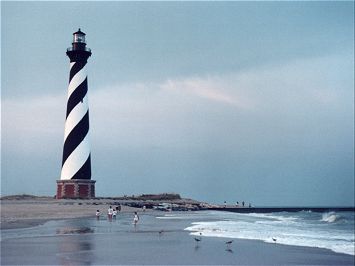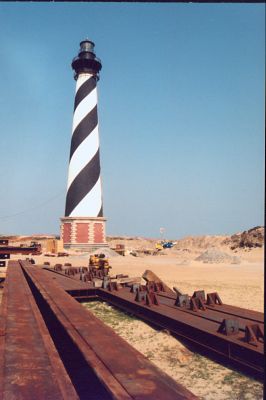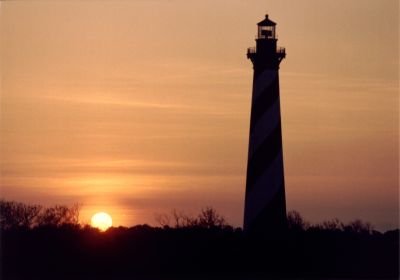Moving the Cape Hatteras Lighthouse
Contents
On June 5, 1999, a huge crowd gathered to watch the moving of the Cape Hatteras Lighthouse to its new location. 550 days after it was closed, the Cape Hatteras Lighthouse reopened to an anxious public. Ten thousand people are expected to visit the lighthouse over the Memorial Day weekend.

Cape Hatteras Lighthouse is the tallest brick lighthouse in the United States. The familiar 200-foot structure with its black and white bands spiraling along its steep walls are easily recognized and grace many calendars and vacationer’s photograph albums.

The famous lighthouse was constructed in 1870 to replace a smaller one, built in 1803. It is a working lighthouse and its beacon of light can be seen as far as twenty miles out to sea. For over a hundred years it has served to warn ships of the dangerous, shallow sandbars called Diamond Shoals.
Why Move a Lighthouse?
Originally, the lighthouse sat 1,500 feet from the shoreline. But because of storms and erosion, at the time of the move, the lighthouse stood only a few feet from the beach. Something had to be done or it would soon topple into the sea.

The National Park Service, which owns the Cape Hatteras National Seashore, on which the lighthouse sits, proposed moving the lighthouse and its outbuildings 2900 feet in an effort to place it as far away from the sea as it had been in 1870.
The Controversy
The proposed move of the lighthouse sparked opposition by many who feared any attempt at relocation would destroy the famous landmark. There were concerns that the old lighthouse could not survive such a move, that disturbing its structure would cause it to crumble or topple into the sea. Other lighthouses in the New England area had been relocated, but the moving of the Hatteras lighthouse caused different concerns. The sandy beach and the towering height of 207 ½ feet made moving the nation’s tallest lighthouse a bigger risk.

Some also felt the lighthouse should be left in its original location, and attempts to preserve it should be made by designing a special protective wall.
For more than a decade, the proposed move remained at the center of a heated debate. Around three million dollars were spent studying options to save the lighthouse. In the meantime, sandbags and rock jetties were used as reinforcements to hold back the waves.
After considering all the options, the National Research Council strongly recommended the lighthouse be moved. The move was first proposed in 1987, but it was not until 1999 that the plans were put into action.
Moving Day
The moving of the lighthouse began on June 5, 1999. A huge crowd showed up to watch the 23-day move. Employees of the International Chimney Corporation and Expert House Movers were chosen to tackle the delicate job. Steel pillars were used to support the tall structure as hydraulic jacks slowly lifted the 4800-ton lighthouse. Vegetable oil was used to lubricate the jacks to keep the move environment-friendly. Steel rails and special rollers were utilized to inch the lighthouse along to its new location. The lighthouse move was a slow and tedious process. It was moved about 25-100 feet a day.

Two lightkeeper’s houses were also moved along with the lighthouse. Care was taken to see that they were positioned in the same relationship as they had been before the move.
Hatteras Lighthouse Today
Today the Hatteras Lighthouse is a popular tourist attraction. It is located off NC Route 12 in Buxton. The hardy can climb the 268 steps to the top for a magnificent view of the shoreline. The site is open daily from 9:30 AM to 4 PM Easter weekend through Columbus day.

